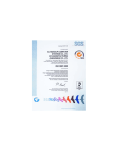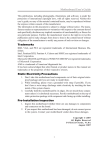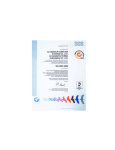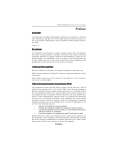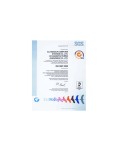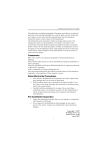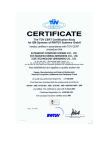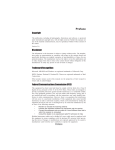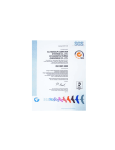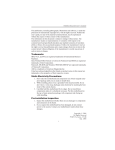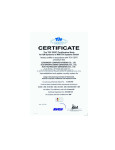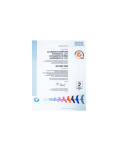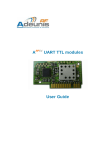Download Untitled
Transcript
i Preface Copyright This publication, including all photographs, illustrations and software, is protected under international copyright laws, with all rights reserved. Neither this manual, nor any of the material contained herein, may be reproduced without written consent of the author. Version 1.0A Disclaimer The information in this document is subject to change without notice. The manufacturer makes no representations or warranties with respect to the contents hereof and specifically disclaims any implied warranties of merchantability or fitness for any particular purpose. The manufacturer reserves the right to revise this publication and to make changes from time to time in the content hereof without obligation of the manufacturer to notify any person of such revision or changes. Trademark Recognition Microsoft, MS-DOS and Windows are registered trademarks of Microsoft Corp. MMX, Pentium, Pentium-II, Pentium-III, Celeron are registered trademarks of Intel Corporation. Other product names used in this manual are the properties of their respective owners and are acknowledged. Federal Communications Commission (FCC) This equipment has been tested and found to comply with the limits for a Class B digital device, pursuant to Part 15 of the FCC Rules. These limits are designed to provide reasonable protection against harmful interference in a residential installation. This equipment generates, uses, and can radiate radio frequency energy and, if not installed and used in accordance with the instructions, may cause harmful interference to radio communications. However, there is no guarantee that interference will not occur in a particular installation. If this equipment does cause harmful interference to radio or television reception, which can be determined by turning the equipment off and on, the user is encouraged to try to correct the interference by one or more of the following measures: • • • • Reorient or relocate the receiving antenna Increase the separation between the equipment and the receiver Connect the equipment onto an outlet on a circuit different from that to which the receiver is connected Consult the dealer or an experienced radio/TV technician for help Shielded interconnect cables and a shielded AC power cable must be employed with this equipment to ensure compliance with the pertinent RF emission limits governing this device. Changes or modifications not expressly approved by the system’s manufacturer could void the user’s authority to operate the equipment. Preface ii Declaration of Conformity This device complies with part 15 of the FCC rules. Operation is subject to the following conditions: • • This device may not cause harmful interference, and This device must accept any interference received, including interference that may cause undesired operation Canadian Department of Communications This class B digital apparatus meets all requirements of the Canadian Interferencecausing Equipment Regulations. Cet appareil numérique de la classe B respecte toutes les exigences du Réglement sur le matériel brouilieur du Canada. About the Manual The manual consists of the following: Describes features of the motherboard. Chapter 1 Introducing the Motherboard Go to Chapter 2 H page 1 Describes installation of motherboard components. Installing the Motherboard Go to H page 7 Provides information on using the BIOS Setup Utility. Chapter 3 Using BIOS Go to Chapter 4 Using the Motherboard Software Chapter 5 ® Using the Intel System Recovery Tool (Intel® SRT) Preface H page 25 Describes the motherboard software Go to H page 41 Describes the motherboard software Go to H page 47 iii TABLE OF CONTENTS Preface i Chapter 1 1 Introducing the Motherboard 1 Introduction......................................................................................1 Feature...............................................................................................2 Motherboard Components.............................................................4 Chapter 2 7 Installing the Motherboard 7 Safety Precautions..........................................................................7 Choosing a Computer Case............................................................7 Installing the Motherboard in a Case............................................7 Checking Jumper Settings...............................................................8 Setting Jumpers......................................................................8 Checking Jumper Settings......................................................9 Jumper Settings......................................................................9 Installing Hardware...................................................................10 Installing the Processor........................................................10 Installing Memory Modules.................................................12 Expansion Slots....................................................................14 Connecting Optional Devices...............................................17 Installing a Hard Disk Drive/CD-ROM/SATA Hard Drive..19 Installing a Floppy Diskette Drive.......................................20 Connecting I/O Devices................................................................21 Connecting Case Components.....................................................22 Front Panel Header..............................................................24 Chapter 3 25 Using BIOS 25 About the Setup Utility.................................................................25 The Standard Configuration................................................25 Entering the Setup Utility......................................................25 Using BIOS.....................................................................................26 Main Features.....................................................................27 Advanced Features..............................................................28 iv PCI Configuration..............................................................28 Boot Configuration.............................................................29 Peripheral Configuration....................................................29 IDE Configuration..............................................................30 Video Configuration............................................................31 USB Configuration..............................................................31 Chipset Configuration............................................................32 Performance Support.......................................................... 33 System Health.....................................................................34 Security Features.................................................................35 Power Features..................................................................36 Boot....................................................................................38 Exit.....................................................................................38 Updating the BIOS.............................................................40 41 Chapter 4 Using the Motherboard Software 41 About the Software CD-ROM.......................................................41 Auto-installing under Windows 2000/XP/Vista.........................41 Running Setup....................................................................42 Manual Installation.........................................................................46 Utility Software Reference.............................................................46 47 Chapter 5 ® ® Using the Intel System Recovery Tool (Intel SRT) 47 About the Intel® System Recovery Tool.....................................47 Features............................................................................................47 Installation Step..............................................................................48 Feature Notes..................................................................................53 1 Chapter 1 Introducing the Motherboard Introduction Thank you for choosing the ISRT 945GCT-M motherboard. This motherboard is a high performance, enhanced function motherboard designed to support the LGA775 socket Intel® CoreTM 2 Duo/Pentium® Dual Core/Pentium® D/Pentium® 4/Celeron® D processors for high-end business or personal desktop markets. The motherboard incorporates the 945GC Northbridge (NB) and ICH7 Southbridge (SB) chipsets. The Northbridge supports a Front Side Bus (FSB) frequency of 1066/ 800/533 MHz using a scalable FSB Vcc_CPU. The memory controller supports DDR2 memory DIMM frequencies of 667/533/400. It supports two DDR2 sockets with up to maximum memory of 2 GB. DDR2 Maximum memory bandwidth of 10.7 Gb/s in dual-channel interleaved mode using DDR2 667 MHz. High resolution graphics via two PCI Express slots, intended for Graphics Interface, are fully compliant to the PCI Express Base Specification revision 1.0a. The ICH7 Southbridge supports two PCI slots which are PCI 2.3 compliant. It implements an EHCI compliant interface that provides 480 Mb/s bandwidth for eight USB 2.0 ports. One onboard IDE connector supports 2 IDE devices in Ultra ATA 100/66/33 mode. The Southbridge integrates a Serial ATA host controller that is SATA 1.0a compliant, supporting four SATA ports with maximum transfer rate up to 3.0 Gb/s each. The motherboard is equipped with advanced full set of I/O ports in the rear panel, including PS/2 mouse and keyboard connectors, COM1, one VGA port, four USB ports, one LAN port and audio jacks for microphone, line-in and line-out. Introducing the Motherboard 2 Feature Processor The motherboard uses an LGA775 type of Intel® CoreTM 2 Duo/Pentium® Dual Core/Pentium® D/Pentium® 4/Celeron® D that carries the following features: • • Accommodates Intel® CoreTM 2 Duo/Pentium® Dual Core/Pentium® D/Pentium® 4/Celeron® D processors Supports a system bus (FSB) of 1066/800/533 MHz Chipset The 945GC Northbridge (NB) and ICH7 Southbridge (SB) chipsets are based on an innovative and scalable architecture with proven reliability and performance. 945GC (NB) • • • • • ICH7 (SB) • • • • • • Memory • • • Supports 32-bit host bus addressing, allowing the CPU to access the entire 2 GB of the memory address space 2 GB/s point-to-point Direct Media Interface (DMI) to ICH7 (1 Gb/s) each direction Supports one PCI Express x16 for Graphics Interface, fully compliant to the PCI Express Base Specification revision 1.0a. Supports 256-Mb, 512-Mb and 1-Gb DDR2 technologies for x8 and x16 devices Supports high quality 3D setup, Render Engine and high-quality texture engine Enhanced DMA Controller, interrupt controller, and timer functions Compliant with PCI Express Base Specification, Revision 1.0a Compliant with PCI 2.3 specification Integrated SATA 3.0 Gb/s Host Controller Integrated USB 2.0 Host Controller supporting up to eight USB 2.0 ports Integrated IDE controller supports Ultra ATA 100/66/ 33 Supports DDR2 667/533/400 DDR SDRAM with Dual-channel architecture Accommodates two unbuffered DIMMs Up to 1 GB per DIMM with maximum memory size up to 2 GB Audio • • • • • 5.1 channel High Definition Audio Codec All DACs Support 192K/96K/48K/44.1KHz DAC sample rate Software selectable 2.5V/3.75V VREFOUT Meets Microsoft WHQL/WLP 2.x audio requirements Direct Sound 3DTM compatible Introducing the Motherboard 3 Onboard LAN (Optional) The onboard LAN controller provides the following features: • • • • • • Integrated 10/100/1000 transceiver Supports PCI v2.3, 32-bit, 33/66 MHz Supports Wake-On-LAN (WOL) function and remote wake-up Supports 10/100 Mb/s N-Way Auto negotiation operation Half/Full duplex capacity Supports Wake-On-LAN (WOL) function and remote wake-up Expansion Options The motherboard comes with the following expansion options: • Two PCI Express slots for Graphics Interface • Two 32-bit PCI v2.3 compliant slots • One IDE connector that supports two IDE devices • One floppy disk drive interface • Four 7-pin SATA connectors The motherboard supports UDMA bus mastering with transfer rates of 100/66/33 Mb/s. Integrated I/O The motherboard has a full set of I/O ports and connectors: • • • • • • Two PS/2 ports for mouse and keyboard One serial port One VGA port Four USB ports One LAN port Audio jacks for microphone, line-in and line-out BIOS Firmware This motherboard uses Insyde BIOS that enables users to configure many system features including the following: • Power management • Wake-up alarms • CPU parameters • CPU and memory timing The firmware can also be used to set parameters for different processor clock speeds. 1. Some hardware specifications and software items are subject to change without prior notice. 2. Due to chipset limitation, we recommend that motherboard be operated in the ambiance between 0 and 50 ° C. Introducing the Motherboard 4 Motherboard Components Introducing the Motherboard 5 Table of Motherboard Components LABEL 1. CPU Socket 2. CPU_FAN 3. DIMM1/3 4. FDD 5. ATX1 6. IDE1 7. SATA1~4 8. F_PANEL 9. CLR_CMOS1 10. F_USB1~2 11. PWR_FAN* 12. SPDIFO 13. F_AUDIO 14. CD_IN 15. PCI1~2 16. PCIEX4 17. PCIEX16 18. SYS_FAN 19. ATX12V COMPONENTS ® ® LGA775 socket for Intel CoreTM 2 Duo/Pentium ® ® ® Dual Core/Pentium D/Pentium 4/Celeron D CPUs CPU cooling fan connector 240-pin DDR2 SDRAM slots Floppy disk drive connector Standard 24-pin ATX power connector Primary IDE connector Serial ATA connectors Front panel switch/LED header Clear CMOS jumper Front Panel USB headers Power cooling fan connector SPDIF out header Front panel audio header Analog audio input connector 32-bit add-on card slots PCI Express Lite for graphics interface PCI Express slot for graphics interface System cooling fan connector Auxiliary 4-pin power connector “*” stands for optional components. This concludes Chapter 1. The next chapter explains how to install the motherboard. Introducing the Motherboard 6 Memo Introducing the Motherboard 7 Chapter 2 Installing the Motherboard Safety Precautions • • • • • Follow these safety precautions when installing the motherboard Wear a grounding strap attached to a grounded device to avoid damage from static electricity Discharge static electricity by touching the metal case of a safely grounded object before working on the motherboard Leave components in the static-proof bags they came in Hold all circuit boards by the edges. Do not bend circuit boards Choosing a Computer Case There are many types of computer cases on the market. The motherboard complies with the specifications for the Micro ATX system case. First, some features on the motherboard are implemented by cabling connectors on the motherboard to indicators and switches on the system case. Make sure that your case supports all the features required. Secondly, this motherboard supports one floppy diskette drive and two enhanced IDE drives. Make sure that your case has sufficient power and space for all drives that you intend to install. Most cases have a choice of I/O templates in the rear panel. Make sure that the I/O template in the case matches the I/O ports installed on the rear edge of the motherboard. This motherboard carries a Micro ATX form factor of 244 x 220 mm. Choose a case that accommodates this form factor. Installing the Motherboard in a Case Refer to the following illustration and instructions for installing the motherboard in a case. Most system cases have mounting brackets installed in the case, which correspond the holes in the motherboard. Place the motherboard over the mounting brackets and secure the motherboard onto the mounting brackets with screws. Ensure that your case has an I/O template that supports the I/O ports and expansion slots on your motherboard. Installing the Motherboard 8 Do not over-tighten the screws as this can stress the motherboard. Checking Jumper Settings This section explains how to set jumpers for correct configuration of the motherboard. Setting Jumpers Use the motherboard jumpers to set system configuration options. Jumpers with more than one pin are numbered. When setting the jumpers, ensure that the jumper caps are placed on the correct pins. The illustrations show a 2-pin jumper. When the jumper cap is placed on both pins, the jumper is SHORT. If you remove the jumper cap, or place the jumper cap on just one pin, the jumper is OPEN. SHORT This illustration shows a 3-pin jumper. Pins 1 and 2 are SHORT. Installing the Motherboard OPEN 9 Checking Jumper Settings The following illustration shows the location of the motherboard jumpers. Pin 1 is labeled. Jumper Settings Jumper Type Description Setting (default) 1-2: Clear CMOS CLR_CMOS1 3-pin 2-3: Normal Clear CMOS Before clearing the CMOS, make sure to turn off the system. 1 CLR_CMOS1 To avoid the system instability after clearing CMOS, we recommend users to enter the main BIOS setting page to “Load Optimal Defaults” and then “Save Changes and Exit”. Installing the Motherboard 10 Installing Hardware Installing the Processor Caution: When installing a CPU heatsink and cooling fan make sure that you DO NOT scratch the motherboard or any of the surfacemount resistors with the clip of the cooling fan. If the clip of the cooling fan scrapes across the motherboard, you may cause serious damage to the motherboard or its components. On most motherboards, there are small surface-mount resistors near the processor socket, which may be damaged if the cooling fan is carelessly installed. Avoid using cooling fans with sharp edges on the fan casing and the clips. Also, install the cooling fan in a well-lit work area so that you can clearly see the motherboard and processor socket. Before installing the Processor This motherboard has a LGA775 socket. When choosing a processor, consider the performance requirements of the system. Performance is based on the processor design, the clock speed and system bus frequency of the processor, and the quantity of internal cache memory and external cache memory. This motherboard automatically determines the CPU clock frequency and system bus frequency for the processor. You may be able to change the settings in the system Setup Utility. We strongly recommend that you do not over-clock processors or other components to run faster than their rated speed. Warning: 1. Over-clocking components can adversely affect the reliability of the system and introduce errors into your system. Over-clocking can permanently damage the motherboard by generating excess heat in components that are run beyond the rated limits. 2. Always remove the AC power by unplugging the power cord from the power outlet before installing or removing the motherboard or other hardware components. Fail-Safe Procedures for Over-clocking When end-users encounter failure after attempting over-clocking, please take the following steps to recover from it. 1. Shut down the computer. 2. Press and hold the “Page Up Key (PgUp)” of the keyboard, and then boot the PC up. 3. Two seconds after the PC boots up, release the “Page Up Key (PgUp)”. 4. The BIOS returns to the default setting by itself. Installing the Motherboard 11 CPU Installation Procedure The following illustration shows CPU installation components. A. Read and follow the instructions shown on the sticker on the CPU cap. B. Unload the cap · Use thumb & forefinger to hold the lifting tab of the cap. · Lift the cap up and remove the cap completely from the socket. C. Open the load plate · Use thumb & forefinger to hold the hook of the lever, pushing down and pulling aside unlock it. · Lift up the lever. · Use thumb to open the load plate. Be careful not to touch the contacts. D. Install the CPU on the socket · Orientate CPU package to the socket. Make sure you match triangle marker to pin 1 location. E. Close the load plate · Slightly push down the load plate onto the tongue side, and hook the lever. · CPU is locked completely. F. Apply thermal grease on top of the CPU. G. Fasten the cooling fan supporting base onto the CPU socket on the motherboard. H. Make sure the CPU fan is plugged to the CPU fan connector. Please refer to the CPU cooling fan user’s manual for more detail installation procedure. 1. To achieve better airflow rates and heat dissipation, we suggest that you use a high quality fan with 3800 rpm at least. CPU fan and heatsink installation procedures may vary with the type of CPU fan/heatsink sup plied. The form and size of fan/heatsink may also vary. 2. DO NOT remove the CPU cap from the socket before installing a CPU. 3. Return Material Authorization (RMA) requests will be accepted only if the motherboard comes with the cap on the LGA775 socket. Installing the Motherboard 12 Installing Memory Modules This motherboard accommodates two memory modules. It can support two 240-pin DDR2 667/533/400. The total memory capacity is 2 GB. DDR2 SDRAM memory module table Memory module Memory Bus DDR2 400 DDR2 533 200 MHz 266 MHz DDR2 667 333 MHz You must install at least one module in any of the two slots. Each module can be installed with 256 MB to 1 GB of memory; total memory capacity is 2 GB. Do not remove any memory module from its antistatic packaging until you are ready to install it on the motherboard. Handle the modules only by their edges. Do not touch the components or metal parts. Always wear a grounding strap when you handle the modules. Installation Procedure Refer to the following to install the memory modules. 1 2 3 4 5 6 This motherboard supports unbuffered DDR2 SDRAM . Push the latches on each side of the DIMM slot down. Align the memory module with the slot. The DIMM slots are keyed with notches and the DIMMs are keyed with cutouts so that they can only be installed correctly. Check that the cutouts on the DIMM module edge connector match the notches in the DIMM slot. Install the DIMM module into the slot and press it firmly down until it seats correctly. The slot latches are levered upwards and latch on to the edges of the DIMM. Install any remaining DIMM modules. Installing the Motherboard 13 Table A: DDR2 (memory module) QVL (Qualified Vendor List) The following DDR2 667/533/400 memory modules have been tested and qualified for use with this motherboard. Type Size DDR2 400 512 MB 256 MB DDR2 533 512 MB 1 GB 256 MB 512 MB DDR2 667 1 GB Vendor Module Name TwinMos msung K4T51083QB-GCCC Corsair Corsair Eipida Hynix Kingston Kingmax Kingston Nanya Ramaxel Ramaxel Aeneon Aeneon Corsair Eipida Hynix Infineon Kingston Kingston PQI Aeneon AET94F-370 VC256MB533D2 4PB11D9CHM E2508AA-DF-E HY5PS121621 Elpida E5116F-5C-E Hynix HY5PS121621 Infineon HYB18T512260AF-3.7 NT5TU32M16AG-37B Elpida E5116AF-5C-E 5PB42 D9DCD AET93F370 AET94F370 Samsung K4T51083QB-ZCD5 04180WB01 HY5PS12821 HY818T512800AF37 33346778 Hynix HYB18T512800AF37 Hynix HY5PS12821 PQI PQB2648D38R0701 PC2-4200U-444 LF 6AD11 Ramaxel D9GCT Ramaxel 5PB32 D9DCN Samsung K4T51083QC Samsung K4T51083QF-ZCD5 Twinmos Elpida E5108AB-5C-E Apacer Elpida E5108AB-5C-E Geil A016E2864T2AG8AKT5H120001 Infineon HY818T512800AF37 33344539 Kingmax KKEA88E4AAKG-37 PQI PQI PQB2648D38R0651 UMAX U2S12D30TP-5C Infineon HYS64T325001HU-3-A HYB18T256 Ramxel 5NB31 D9DCG A-DATA AD29608A88-3EG Corsair Corsair K4T5108QC Corsair VALUESELECT 32M8CEC GEIL GEIL GL2L64M088BA30AW GEIL GL2L64M088BA18W Ramxel 5LB31 D9DCL Samsung K4T51083QC Sync Max 04400WB01 R050008A Transcend JetRam J12Q3AB-6 Transcend SEL520ZCE6 K4T51083QC Twinmos TMM6208G8M30B Apacer Elpida AM4B5708GEWS7E0637F Infineon HYB18T51512800BF3S PQI PQI PQB2648D38R0648 Samsung K4T51083QC UMAX U2S12030TP-6E TBF614-L93G Installing the Motherboard 14 Expansion Slots Installing Add-on Cards The slots on this motherboard are designed to hold expansion cards and connect them to the system bus. Expansion slots are a means of adding or enhancing the motherboard’s features and capabilities. With these efficient facilities, you can increase the motherboard’s capabilities by adding hardware that performs tasks that are not part of the basic system. PCIEX16 Slot The PCI Express slot is used to install an external PCI Express graphics card that is fully compliant to the PCI Express Base Specification revision 1.0a. PCIEX4 The PCI Express Lite is used to install an external PCI Express graphics card that is fully compliant to the PCI Express Base Specification revision 1.0a. Lite PCI 1~2 Slots This motherboard is equipped with two standard PCI slots. PCI stands for Peripheral Component Interconnect and is a bus standard for expansion cards, which for the most part, is a supplement of the older ISA bus standard. The PCI slots on this board are PCI v2.3 compliant. Before installing an add-on card, check the documentation for the card carefully. If the card is not Plug and Play, you may have to manually configure the card before installation. Installing the Motherboard 15 Follow these instructions to install an add-on card: 1 2 3 Remove a blanking plate from the system case corresponding to the slot you are going to use. Install the edge connector of the add-on card into the expansion slot. Ensure that the edge connector is correctly seated in the slot. Secure the metal bracket of the card to the system case with a screw. 1. For some add-on cards, for example graphics adapters and network adapters, you have to install drivers and software before you can begin using the add-on card. 2. The onboard PCI interface does not support 64-bit SCSI cards. Table B: Supported PCI Express VGA Card List for PCI Express Slot (PCI Express x4) VGA Chip Model Name ASUS EAX1900XT 512MB ASUS EAX1950XTX 512MB ASUS X800XT 256MB ASUS X850XT PE 246MB ATI ATI X1600XT 256M Colorful X300SE 128MB GIGABYTE X700PRO128MB MSI RX550 256MB MSI X1300 256MB Albatron 256MB7600GT 256M ASUS EN7600GS 512MB BITC 6200TC 16MB ELSA 6600GT 128MB GEFORCE 7300GS128MB GEFORCE 6600LE 256MB GIGABYTE GV-NX73TC512DL-RH GF7300GS 512MB NVIDIA GIGABYTE 6200 128MB Leadtek 6800 Ultra 256MB NVIDIA PVX5300 128MB NVIDIA PCX5750 128MB PIxelView PV-N70GXE 256MB WinfastPX6500 128MB Winfast PX6600GT128MB Winfast 6800GS 256MB Winfast PX7900GT 256MB Installing the Motherboard 16 Surround Display Function Init Display Onboard PCI-E PCI-E Test Result First VGA x16 x4 PCI-E Card Install WinXP o x x pass PCI-E Card x o x pass PCI-E Card x x o pass o pass PCI-E Card o x Onboard VGA o x o Not support PCI-E Card x o o Not support 1. When the driver of onboard VGA is installed first, the primary Graphics in Windows will be onboard VGA. However, if the driver of add-on PCI Express Graphics card is installed first, the primary Graphics in Windows will be add-on PCI Express Graphics card. 2. If you install the add-on PCI Express VGA card, BIOS setup will automatically disable the onboard VGA after loading optimal defaults. To enable the Surround Display function, make sure to manually enable onboard VGA in the BIOS setting. 3. When using surround display, please make sure that “Init Display First” in “CMOS Setup Utility” should be selected to “Onboard VGA”. ADD2 Card Function When you want to perform dual view (clone) function, only the following assemble supports. Function PCI-E x16 PCI-E x4 Dual View (Clone) o x Test Result pass Installing the Motherboard Remark 17 Connecting Optional Devices Refer to the following for information on connecting the motherboard’s optional devices: F_AUDIO: Front Panel Audio header This header allows the user to install auxiliary front-oriented microphone and lineout ports for easier access. Pin 1 2 3 4 5 6 7 AUD_MIC Signal Name Function Pin Front Panel Microphone input signal AUD_GND Ground used by Analog Audio Circuits MIC_BIAS Microphone Power 8 9 10 Key No Pin AUD_F_L Left Channel Audio signal to Front Panel AUD_RET_L Left Channel Audio signal to Return from Front Panel AUD_VCC Filtered +5V used by Analog Audio Circuits AUD_F_R Right Channel audio signal to Front Panel AUD_RET_R RightChannelAudiosignaltoReturnfromFrontPanel REVD Reserved CD_IN: Analog Audio Input connector Pin 1 2 3 4 Signal Name Signal Name Function CD_L CD In right channel GND Ground GND CD_R Ground CD In left channel Installing the Motherboard 18 SATA1~4: Serial ATA connectors These connectors are used to support the new Serial ATA devices for the highest data transfer rates (3.0 Gb/s), simpler disk drive cabling and easier PC assembly. It eliminates limitations of the current Parallel ATA interface. But maintains register compatibility and software compatibility with Parallel ATA. Pin Signal Name 1 3 Ground 5 7 Pin Signal Name TX+ TX- 2 4 RXGround 6 - RX+ - Ground F_USB1~2: Front Panel USB headers The motherboard has four USB ports installed on the rear edge I/O port array. Additionally, some computer cases have USB ports at the front of the case. If you have this kind of case, use auxiliary USB connector to connect the front-mounted ports to the motherboard. Pin Signal Name Function 1 USBPWR 2 3 4 5 6 7 8 9 10 USBPWR Front Panel USB Power USB_FP_P0- USB Port 0 Negative Signal USB_FP_P1- USB Port 1 Negative Signal Front Panel USB Power USB_FP_P0+ USB Port 0 Positive Signal USB_FP_P1+ USB Port 1 Positive Signal GND GND Ground Ground Key No pin USB_FP_OC0 Overcurrent signal Please make sure that the USB cable has the same pin assignment as indicated above. A different pin assignment may cause damage or system hang-up. SPDIFO: SPDIF out header This is an optional header that provides an SPDIFO (Sony/Philips Digital Interface) output to digital multimedia device through optical fiber or coaxial connector. Pin Signal Name 1 2 3 4 SPDIFOUT +5V Key GND Installing the Motherboard 19 Installing a Hard Disk Drive/CD-ROM/SATA Hard Drive This section describes how to install IDE devices such as a hard disk drive and a CDROM drive. About IDE Devices Your motherboard has one IDE channel interface. An IDE ribbon cable supporting two IDE devices is bundled with the motherboard. You must orient the cable connector so that the pin1 (color) edge of the cable corresponds to the pin 1 of the I/O port connector. IDE1: IDE Connector This motherboard supports four high data transfer SATA ports with each runs up to 3.0 Gb/s. To get better system performance, we recommend users connect the CDROM to the IDE channel, and set up the hard dives on the SATA ports. IDE devices enclose jumpers or switches used to set the IDE device as MASTER or SLAVE. Refer to the IDE device user’s manual. Installing two IDE devices on one cable, ensure that one device is set to MASTER and the other device is set to SLAVE. The documentation of your IDE device explains how to do this. About SATA Connectors Your motherboard features four SATA connectors supporting a total of four drives. SATA refers to Serial ATA (Advanced Technology Attachment) is the standard interface for the IDE hard drives which are currently used in most PCs. These connectors are well designed and will only fit in one orientation. Locate the SATA connectors on the motherboard and follow the illustration below to install the SATA hard drives. Installing Serial ATA Hard Drives To install the Serial ATA (SATA) hard drives, use the SATA cable that supports the Serial ATA protocol. This SATA cable comes with an SATA power cable. You can connect either end of the SATA cable to the SATA hard drive or the connector on the motherboard. SATA cable (optional) SATA power cable Installing the Motherboard (optional) 20 Refer to the illustration below for proper installation: 1 2 3 Attach either cable end to the connector on the motherboard. Attach the other cable end to the SATA hard drive. Attach the SATA power cable to the SATA hard drive and connect the other end to the power supply. This motherboard does not support the “Hot-Plug” function. Installing a Floppy Diskette Drive FDD: Floppy Disk Connector Connect the single end of the of the floppy connector to the onboard floppy connector firstly, and then connect the remaining plugs on the other end to the floppy drives correspondingly. You must orient the cable connector so that the pin 1 (color) edge of the cable corresponds to the pin 1 of the I/O port connector. Installing the Motherboard 21 Connecting I/O Devices The backplane of the motherboard has the following I/O ports: PS2 Mouse Use the upper PS/2 port to connect a PS/2 pointing device. PS2 Keyboard Use the lower PS/2 port to connect a PS/2 keyboard. Serial Port (COM1) Use the COM port to connect serial devices such as mice or fax/modems. VGA Port Connect your monitor to the VGA port. LAN Port Connect an RJ-45 jack to the LAN port to connect your computer to the Network. USB Ports Use the USB ports to connect USB devices. Audio Ports Use the three audio jacks to connect audio devices. The first jack is for stereo line-in signal. The second jack is for stero line-out signal. The third jack is for microphone. Installing the Motherboard 22 Connecting Case Components After you have installed the motherboard into a case, you can begin connecting the motherboard components. Refer to the following: 1 Connect the CPU cooling fan cable to CPU_FAN. 2 Connect the system cooling fan connector to SYS_FAN. 3 Connect the case switches and indicator LEDs to the F_PANEL. 4 Connect the standard power supply connector to ATX1. 5 Connect the auxiliary case power supply connector to ATX12V. 6 Connect the power fan connector to PWR_FAN (optional). Connecting 24-pin power cable The ATX 24-pin connector allows you to connect to ATX v2.x power supply. With ATX v2.x power supply, users please note that when installing 24-pin power cable, the latches of power cable and the ATX1 match perfectly. 24-pin power cable Connecting 4-pin power cable The ATX12V power connector is used to provide power to the CPU. When installing 4-pin power cable, the latches of power cable and the ATX12V match perfectly. 4-pin power cable Installing the Motherboard 23 CPU_FAN: FAN Power Connector Pin 1 2 3 4 Signal Name GND +12V Sense Control Function System Ground Power +12V Sensor CPU FAN control Users please note that the fan connector supports the CPU cooling fan of 1.1A ~ 2.2A (26.4W max) at +12V. SYS_FAN: System Cooling FAN Power Connector Pin 1 2 3 Signal Name Function System Ground Power +12V Sensor GND +12V Sense ATX1: ATX 24-pin Power Connector Pin Signal Name 1 2 3 4 5 6 7 8 9 +3.3V 10 11 12 +12V Pin 13 14 15 16 17 18 19 20 21 +3.3V Ground +5V Ground +5V Ground PWRGD +5VSB 22 23 24 +12V +3.3V Signal Name +3.3V -12V Ground PS_ON Ground Ground Ground -5V +5V +5V +5V Ground ATX12V: ATX 12V Power Connector Pin 1 2 3 4 Signal Name Ground Ground +12V +12V PWR_FAN: FAN Power Connector (optional) Pin 1 2 3 Signal Name GND +12V NC Function System Ground Power +12V Not connect Installing the Motherboard 24 Front Panel Header The front panel header (F_PANEL) provides a standard set of switch and LED headers commonly found on ATX or Micro ATX cases. Refer to the table below for information: Pin Signal Function Pin Signal Function 1 HD_LED_P Hard disk LED(+) 2 FP PWR/SLP *MSG LED(+) 3 HD_LED_N Hard disk LED(- ) 4 FP PWR/SLP *MSG LED(-) 5 RST_SW_N Reset Switch(-) 6 PWR_SW_P Power Switch(+) 7 RST_SW_P Reset Switch(+) 8 PWR_SW_N Power Switch(-) 9 RSVD Reserved 10 Key No pin * MSG LED (dual color or single color) Hard Drive Activity LED Connecting pins 1 and 3 to a front panel mounted LED provides visual indication that data is being read from or written to the hard drive. For the LED to function properly, an IDE drive should be connected to the onboard IDE interface. The LED will also show activity for devices connected to the SCSI (hard drive activity LED) connector. Power/Sleep/Message waiting LED Connecting pins 2 and 4 to a single or dual-color, front panel mounted LED provides power on/off, sleep, and message waiting indication. Reset Switch Supporting the reset function requires connecting pins 5 and 7 to a momentarycontact switch that is normally open. When the switch is closed, the board resets and runs POST. Power Switch Supporting the power on/off function requires connecting pins 6 and 8 to a momentary-contact switch that is normally open. The switch should maintain contact for at least 50 ms to signal the power supply to switch on or off. The time requirement is due to internal de-bounce circuitry. After receiving a power on/off signal, at least two seconds elapses before the power supply recognizes another on/off signal. This concludes Chapter 2. The next chapter covers the BIOS. Installing the Motherboard 25 Chapter 3 Using BIOS About the Setup Utility The computer uses the latest Insyde BIOS with support for Windows Plug and Play. The CMOS chip on the motherboard contains the ROM setup instructions for configuring the motherboard BIOS. The BIOS (Basic Input and Output System) Setup Utility displays the system’s configuration status and provides you with options to set system parameters. The parameters are stored in battery-backed-up CMOS RAM that saves this information when the power is turned off. When the system is turned back on, the system is configured with the values you stored in CMOS. The BIOS Setup Utility enables you to configure: • • • • Hard drives, diskette drives and peripherals Video display type and display options Password protection from unauthorized use Power Management features The settings made in the Setup Utility affect how the computer performs. Before using the Setup Utility, ensure that you understand the Setup Utility options. This chapter provides explanations for Setup Utility options. The Standard Configuration A standard configuration has already been set in the Setup Utility. However, we recommend that you read this chapter in case you need to make any changes in the future. This Setup Utility should be used: • • • • • when changing the system configuration when a configuration error is detected and you are prompted to make changes to the Setup Utility when trying to resolve IRQ conflicts when making changes to the Power Management configuration when changing the password or making other changes to the Security Setup Entering the Setup Utility When you power on the system, BIOS enters the Power-On Self Test (POST) routines. POST is a series of built-in diagnostics performed by the BIOS. After the POST routines are completed, the following message appears: Using BIOS 26 Using BIOS When you start the Setup Utility, the main menu appears. The main menu of the Setup Utility displays a list of the options that are available. A highlight indicates which option is currently selected. Use the cursor arrow keys to move the highlight to other options. When an option is highlighted, execute the option by pressing <Enter>. Some options lead to pop-up dialog boxes that prompt you to verify that you wish to execute that option. Other options lead to dialog boxes that prompt you for information. Some options (marked with a triangle f) lead to submenus that enable you to change the values for the option. Use the cursor arrow keys to scroll through the items in the submenu. In this manual, default values are enclosed in parenthesis. Submenu items are denoted by a triangle f . The default BIOS setting for this motherboard applies for most conditions with optimum performance. It is not suggested to change the default values in the BIOS setup and the manufacture takes no responsibility to any damage caused by changing the BIOS settings. BIOS Navigation Keys The BIOS navigation keys are listed below: KEY FUNCTION <> Select Screen qr Select Item +- Change Field Tab Select Field F1 General Help F9 Setup Defaults F10 Save and Exit ESC Exit For the purpose of better product maintenance, the manufacture reserves the right to change the BIOS items presented in this manual. The BIOS setup screens shown in this chapter are for reference only and may differ from the actual BIOS. Please visit the manufacture’s website for updated manual. Using BIOS 27 Main Features This option displays basic information about your system. Main Advanced InsydeH2O Setup Utility Security Power Insyde H2O version 945GCT-M Ver 1.4 07/10/2007 Processor Type System Bus Speed System Memory Speed Cache RAM Genuine Intel (R)CPU @ 2.40GHz 200 MHz [Not Detected] 512 KB Total Memory Channel Status DIMM 0 DIMM 1 [Not Detected] Single Channel [Not Installed] [Not Installed] ISRT Language <English> System Time System Date [05:38:45] [01/01/2004] Boot Exit Select the current default language used by the InsydeH2O. +- Select Boot Device Selecct Screen Select Item Enter Select fSubMenu F9 = Setup Defaults F10 = Save and Exit Esc = Exit <> mn Insyde H2O version (945GCT-M Ver 1.4) This item shows Insyde H2O version. Processor Type The item is automatically detected by the system at start up time. The Processor item shows the processor type and speed installed in your computer. This is displayonly field.You cannot make changes to this field. System Bus/Memory Speed This item shows the speed of Bus and Memory. Cache RAM (512 KB) This item shows cache size of RAM. Total Memory (Not Detected) The item is automatically detected by the system at start up time. This is displayonly field. You cannot make changes to this field. Channel Status (Single Channel) About the channel status, it will show “Single Channel” if memory slot plugs one memory DIMM. Otherwise, it will show “Dual Channel” if memory slot plugs two memory DIMMs. DIMM 0/1 (Not Installed) This item shows the memory capacity of DIMM. ISRT Language (English) This item determines the Language version of the BIOS. System Time and Date The System Time and Date items show the current date and time on the computer. If you are running a Windows OS, these items are automatically updated whenever you make changes to the Windows Date and Time Properties utility. Using BIOS 28 fAdvanced Features This option defines advanced information about your system. Main f f f f f f f f f Advanced InsydeH2O Setup Utility Power Security Boot Exit PCI Configuration PCI Configuration Boot Configuration Peripheral Configuration IDE Configuration Video Configuration USB Configuration Chipset Configration Performance Support System Health +- Select Boot Device Selecct Screen Select Item Enter Select fSubMenu F9 = Setup Defaults F10 = Save and Exit Esc = Exit <> mn fPCI Configuration (Press Enter) Scroll to this item and press <Enter> to view the following screen: InsydeH2O Setup Utility Main Advanced Power Security PCI Configuration PCI Slot1 IRQ Priority PCI Slot2 IRQ Priority <Auto> <Auto> Boot Exit Manual IRQ Selection does not garantee PCI slot device will be configured with choice because PnP ISA cards (if present) are assigned the availabe resources before PCI device. +- Select Boot Device Selecct Screen Select Item Enter Select fSubMenu F9 = Setup Defaults F10 = Save and Exit Esc = Exit <> mn PCI Slots1/2 IRQ Priority (Auto) Manual IRQ Selection does not guarantee PCI slot device will be configured with choice because PnP ISA cards (if present) are assigned the availabe resources before PCI device. Press <Esc> to return to the Advanced Features page. Using BIOS 29 f Boot Configuration (Press Enter) Scroll to this item and press <Enter> to view the following screen: Main Advanced InsydeH2O Setup Utility Power Security Boot Exit Selects Power-on state for Numlock Boot Configuration Numlock Zip Emulation Type FDD Controller FDD Write Protect HALT ON <On> <FDD> <Enabled> <Disabled> <No Error> +- Select Boot Device Selecct Screen Select Item Enter Select fSubMenu F9 = Setup Defaults F10 = Save and Exit Esc = Exit <> mn Numlock (On) The item selects Power-on state for Numlock. Zip Emulation Type (FDD) The item shows the type of zip emulation. FDD Controller (Enabled) The item enables or disable the floppy disk drive interface. FDD Write Protect (Disabled) The item enables or disable the FDD write protect function. HALT ON (No Error) This item defines the operation of the system POST(Power On Self Test) routine. You can use this item to select which types of errors in the POST are sufficient to halt system. Press <Esc> to return to the Advanced Features page. f Peripheral Configuration (Press Enter) Scroll to this item and press <Enter> to view the following screen: Main Advanced InsydeH2O Setup Utility Power Security Boot Peripheral Configuration Serial Port A <Auto> Parallel Port Mode <Auto> <ECP> Azalia Realtek LAN <Auto> <Enabled> Configure Serial port A using uptions: [Disable] No Configuration [Enable] User Configuration [Auto] EFI/OS chooses configuration +- Select Boot Device Selecct Screen Select Item Enter Select fSubMenu F9 = Setup Defaults F10 =Save and Exit Esc =Exit <> mn Using BIOS Exit 30 Serial Port A (Auto) The item is used to assign the I/O address and interrupt request (IRQ) for onboard serial port 1 (COM1) Parallel Port Mode (ECP) Use this item to set the parallel port mode. You can select Normal (Standard Parallel Port),ECP (Extended Capabilities Port), EPP (Enhanced Parallel Port), or EPP & ECP. Azalia (Auto) This option allows you to control the onboard Azalia audio. Disable this item if you are going to install a PCI audio add-on card. Realtek LAN (Enabled) Use this item to enable or disable the Onboard LAN Device. Press <Esc> to return to the Advanced Features page. fIDE Configuration (Press Enter) Scroll to this item and press <Enter> to view the following screen: Main Advanced InsydeH2O Setup Utility Power Security Boot IDE Configuration IDE Controller Compatible <Enabled> <Enhanced Non-AHCI> Exit DISABLED: disables both the PATA & SATA IDE controllers. BOTH: enables both the PATA & SATA IDE controllers. fChannel 1 Master fChannel 1 Slave fChannel 2 Master fChannel 2 Slave fChannel 3 Master fChannel 3 Slave fChannel 4 Master fChannel 4 Slave [Not Installed [Not Installed [Not Installed [Not Installed [Not Installed [Not Installed [Not Installed [ST3160812AS ] ] ] ] ] ] ] ] +- Select Boot Device Selecct Screen Select Item Enter Select fSubMenu F9 = Setup Defaults F10 =Save and Exit Esc =Exit <> mn IDE Controller (Enabled) Use this item to enable or disable either or both of the onboard Primary and Secondary IDE channels. Compatible (Enhanced Non-AHCI) When this item sets to Compatible mode, SATA and PATA drives are auto-detected and placed in Legacy mode. If it sets to Enhanced (non-AHCI) mode, SATA and PATA drives are auto-detected and placed in Native IDE mode. Channel 1/2/3/4 Master/Slave Your computer has four IDE channels and each channel can be installed with one or two devices (Master and Slave). In addition, this motherboard supports four SATA channels and each channel allows one SATA device to be installed. Use these items to configure each device on the IDE channel. Press <Esc> to return to the Advanced Features page. Using BIOS 31 fVideo Configuration (Press Enter) Scroll to this item and press <Enter> to view the following screen: Main Advanced InsydeH2O Setup Utility Power Security Exit Select Memory Allocation Mode Video Configuration Primary Video Device Boot <Auto> IGD - Pre-allocat Memory: <UMA = 8MB> IGD - DVMT Mode Select <DVMT Mode> IGD - DVMT Size <DVMT 128MB> +- Select Boot Device Selecct Screen Select Item Enter Select fSubMenu F9 = Setup Defaults F10 = Save and Exit Esc = Exit <> mn Primary Video Device (Auto) Use this item to set the primary video device. IGD - pre-allocate Memory (UMA=8MB) This item lets you allocate a portion of the main memory for the onboard VGA display application. IGD - DVMT Mode Select (DVMT Mode) This item allows you to select the DVMT operating mode. IGD - DVMT Size (DVMT 128MB) When set to DVMT Mode, the graphics chip will dynamically allocate system memory as graphics memory, according to system and graphics requirements. Press <Esc> to return to the Advanced Features page. f USB Configuration (Press Enter) Scroll to this item and press <Enter> to view the following screen: Main Advanced InsydeH2O Setup Utility Power Security USB Configuration USB2.0 USB Driver Select <Enabled> <Legacy USB> Boot Exit Disable this option when a USB2.0 driver is not available. +- Select Boot Device Selecct Screen Select Item Enter Select fSubMenu F9 = Setup Defaults F10 =Save and Exit Esc =Exit <> mn Using BIOS 32 USB 2.0 (Enabled) Use this item to enable or disable the USB 2.0 function. USB Driver Select (Legacy USB) Use this item to enable or disable support for legacy USB devices. Press <Esc> to return to the Advanced Features page. f Chipset Configuration (Press Enter) Scroll to this item and press <Enter> to view the following screen: Main Advanced InsydeH2O Setup Utility Power Security Chipset Configuration Setup Warning: Setting items on this screen to incorrect values May cause your system to malfunction! System Memory Frequency <Auto> Dram Timing Selectable RAM CAS# Latency RAM RAS Act. to Pre. RAM RAS# to CAS# delay RAM RAS# Precharge Refresh Cycle Time Refresh Mode Select <Default> <5> <15> <02> <02> <0> <15.6 us> Boot Exit Allows override of detected memory frequency value. +- Select Boot Device Selecct Screen Select Item Enter Select fSubMenu F9 = Setup Defaults F10 = Save and Exit Esc = Exit <> mn System Memory Frequency (Auto) Use this item to enable or disable the frequency of system memory. Dram Timing Selectable (Default) Use this option to determine if the memory timings should be read from SPD or set up manually. RAM CAS# latency (5) This item determines the operation of DDR RAM memory CAS (column address strobe). It is recommended that you leave this item at the default value. RAM RAS Act. to Pre (15) Depending on your SDRAM module structure, the 4-Way setting can offer the best performance. If you choose the wrong setting, the computer system will not run in a stable number. RAM RAS# to CAS# delay (02) This item specifies the RAS# to CAS# read write delay time to the same bank. RAM RAS# Precharge (02) This item specifies the RAS# precharge time. Refresh Cycle Time (0) This item means Refresh cycle time. Using BIOS 33 Refresh Mode Select (15.6 us) This item is uesd to select refresh mode. Press <Esc> to return to the Advanced Features page. fPerformance Support (Press Enter) Scroll to this item and press <Enter> to view the following screen: Main Advanced InsydeH2O Setup Utility Power Security Boot Exit Performance Support Spread Spectrum Set Processor Multiplier CPU Clock <Enabled> <12> <200> +- Select Boot Device Selecct Screen Select Item Enter Select fSubMenu F9 = Setup Defaults F10 = Save and Exit Esc = Exit <> mn Spread Spectrum (Enabled) If you enable this item, it can significantly reduce the EMI (Electro-Magnetic Interference) generated by the system. Set Processor Multiplier (12) This item is used to set processor multiplier. CPU Clock (200) This item shows the frequency of the CPU installed in your system. Press <Esc> to return to the Advanced Features page. Using BIOS 34 f System Health (Press Enter) Scroll to this item and press <Enter> to view the following screen: Main Advanced InsydeH2O Setup Utility Power Security System Health CPU Temperature System Temperature CPU Fan Speed CPU Vcore VDIMM : 25 Degree : 25 Degree :3924 RPM : 1.32V : 1.83V Shutdown Temperature Warning Temperature <Disabled> <Disabled> SMART FAN Control <Disabled> Boot Exit Disabled: Don’t monitor current temperature. 70-80 Degree: Alarm when current temperature over than the selected temperature. +- Select Boot Device Selecct Screen Select Item Enter Select fSubMenu F9 = Setup Defaults F10 = Save and Exit Esc = Exit <> mn System Component Characteristics These fields provide you with information about the system’s current operating status. You cannot make changes to these fields. • • • • • CPU Temperature System Temperature CPU Fan Speed CPU Vcore VDIMM Shutdown Temperature (Disabled) Enable you to set the maximum temperature the system can reach before powering down. Warning Temperature (Disabled) This item allows you to manually set the warning temperature of the system. SMART FAN Control(Disabled) This item allows users to enable or disable smart fan control function. Press <Esc> to return to the Advanced Features page. Using BIOS 35 Security Features This page helps you install or change a password. Main Advanced InsydeH2O Setup Utility Security Power Boot Supervisor Password : User Password : Not Installed Not Installed Exit Install or Change the password. Set Supervisor Password Set User Password +- Select Boot Device Selecct Screen Select Item Enter Select fSubMenu F9 = Setup Defaults F10 = Save and Exit Esc = Exit <> mn Supervisor Password/User Password (Not Installed) This item indicates whether a supervisor password/user password has been set. If the password has been installed, Enabled displays. If not, Disabled displays. Set Supervisor Password/Set User Password You can select this option and press <Enter> to access the sub-menu. You can use the sub-menu to change the supervisor password. Using BIOS 36 Power Features This page sets up some parameters for system power management operation. InsydeH2O Setup Utility Main Advanced Power Boot Exit These items control various CPU parameters. f Advanced CPU Control ACPI S1 : <Enabled> ACPI S3 : <Enabled> Resume By PS2 KB (S3) <Disabled> Resume By PS2 Mouse (S3) <Disabled> Resume By USB (S3) <Disabled> Soft-Off by PWR-BTTN: <Instant-Off> Wake on PME <Enabled> Wake on Modem Ring <Disabled> +- Select Boot Device Selecct Screen Select Item Enter Select fSubMenu F9 = Setup Defaults F10 = Save and Exit Esc = Exit <> mn f Advanced CPU Control (Press Enter) Scroll to this item and press <Enter> to view the following screen: Main Advanced InsydeH2O Setup Utility Power Boot Exit Enable /Disable GV3. Advanced CPU Control Intel (R) SpeedStep(tm) Tech Thermal Management CMP Support Execute Disable Bit Venderpool Technology C1E Support <Enabled> <TM1> <Auto> <Disabled> <Enabled> <Enabled> +- Select Boot Device Selecct Screen Select Item Enter Select fSubMenu F9 = Setup Defaults F10 =Save and Exit Esc =Exit <> mn Intel(R) SpeedStep(tm) Tech (Enabled) This item enables or disables the Intel (R) SpeedStep (tm) technology. When enabled, allows enhance Intel SpeedStep Technology transitions. Thermal Management (TM1) This item displays CPU’s temperature and enables you to set a safe temperature to Prescott CPU. CMP Support (Auto) This item is used to control the Core Multi-Processing. Execute Disabled Bit (Disasbled) This item is a security feature that helps you protect your CPU and operating system against malicious software exrcuting code. it is available when CPU supports the feature. Using BIOS 37 Venderpool Technology (Enabled) Use this item to enable or disable the Venderpool Technology, which is only for the CPU supporting the VT function. C1E Support (Enabled) Use this item to decrease the bus ratio reduces the consumption of CPU electricity and power. Press <Esc> to return to the Power Features page. ACPI S1/S3 (Enabled) This item enable or disable ACPI S1/S3 function. Resume By PS2 KB/Mouse (S3) (Disabled) These items enable or disable you to allow keyboard/mouse activity to awaken the system from power saving mode. Resume By USB (S3) (Disabled) This item allows the activity of the USB devices (keyboard and mouse) to wake-up the system from S3 sleep state. Soft-Off by PWR-BTTN (Instant-Off) Under ACPI (Advanced Configuration and Power management Interface) you can create a software power down. In a software power down, the system can be resumed by Wake Up Alarms. This item lets you install a software power down that is controlled by the power button on your system. If the item is set to Instant-Off, then the power button causes a software power down. If the item is set to Delay 4 Sec. Then you have to hold the powerbutton down for four seconds to cause a software power down. Wake on PME (Disabled) The system can be turned off with a software command. If you enable this item, the system can automatically resume if there is an incoming call on the PCI Modem or PCI LAN card.You must use an ATA power supply in order to use this feature. Use this item to do wake-up action if inserting the PCI card. Wake on Modem Ring (Disabled) The system can be turned off with a software command. If you enable this item, the systemcan automatically resume if there is an incoming call on the Modem. You must use an ATA power supply in order to use this feature. Using BIOS 38 Boot This option defines advanced information about your system. InsydeH2O Setup Utility Main Advanced Security Onboard LAN Boot ROM Power <Disabled> Boot Exit Disables or enables PXE boot to LAN. 1st : ST3160812AS +- Select Boot Device Selecct Screen Select Item Enter Select fSubMenu F9 = Setup Defaults F10 = Save and Exit Esc = Exit <> mn Onboard LAN Boot ROM (Disabled) This item allows you to enable or disable the onboard LAN Boot ROM function. f Exit This option displays exit options about your system. InsydeH2O Setup Utility Main Advanced Power Boot Exit Exit system setup and save your changes. Exit Saving Changes Exit Discarding Changes Load Optimal Defaults Load Custom Defaults Save Custom Defaults Discard Changes +- Select Boot Device Selecct Screen Select Item Enter Select fSubMenu F9 = Setup Defaults F10 = Save and Exit Esc = Exit <> mn Exit Saving Changes Highlight this item and press <Enter> to save the changes that you have made in the Setup Utility and exit the Setup Utility. When the Save and Exit dialog box appears, press <Yes> to save and exit, or press <No> to return to the main menu. Exit discarding Changes Highlight this item and press <Enter> to discard any changes that you have made in the Setup Utility and exit the Setup Utility. When the Exit Without Saving dialog box appears, press <Yes> to discard changes and exit, or press <No> to return to the main menu. Using BIOS 39 Load Optimal Defaults This option opens a dialog box that lets you install optimized defaults for all appropriate items in the Setup Utility. Press <Yes> and then <Enter> to install the defaults. Press <No> and then <Enter> to not install the defaults. If you only want to install setup defaults for a specific option, select and display that option, and then press <F9>. Load Custom Defaults If you saved your CMOS setting as custom defaults before the BIOS upgrade, then go to the Exit menu and choose the “Load Custom Defaults“ option to return it to your previous custom settings. Save Custom Defaults Highlight this item and press <Enter> to save the defaults as custom defaults. When the Save and Exit dialog box appears, press <Yes> to save and exit, or press <No> to return to the main menu. Discard Changes Highlight this item and press <Enter> to discard any changes that you have made in the Setup Utility and exit the Setup Utility. Using BIOS 40 Updating the BIOS You can download and install updated BIOS for this motherboard from the manufacturer’s Web site. New BIOS provides support for new peripherals, improvements in performance, or fixes for known bugs. Install new BIOS as follows: 1 2 3 4 5 6 7 If your motherboard has a BIOS protection jumper, change the setting to allow BIOS flashing. If your motherboard has an item called Firmware Write Protect in Advanced BIOS features, disable it. (Firmware Write Protect prevents BIOS from being overwritten.) Create a bootable system disk. (Refer to Windows online help for information on creating a bootable system disk.) Download the Flash Utility and new BIOS file from the manufacturer’s Web site. Copy these files to the bootable device. Turn off your computer and insert the bootable device in your computer. (You might need to run the Setup Utility and change the boot priority items on the Advanced BIOS Features Setup page, to force your computer to boot from the bootable device first.) At the C:\ or A:\ prompt, type the Flash Utility program name and the file name of the new bios and then press <Enter>. Example: AMINF340.EXE 040706.ROM When the installation is complete, remove the bootable device from the computer and restart your computer. If your motherboard has a Flash BIOS jumper, reset the jumper to protect the newly installed BIOS from being overwritten. The computer will restart automatically. This concludes Chapter 3. Refer to the next chapter for information on the software supplied with the motherboard. Using BIOS 41 Chapter 4 Using the Motherboard Software About the Software CD-ROM The support software CD-ROM that is included in the motherboard package contains all the drivers and utility programs needed to properly run the bundled products. Below you can find a brief description of each software program, and the location for your motherboard version. More information on some programs is available in a README file, located in the same directory as the software. Before installing any software, always inspect the folder for files named README.TXT, INSTALL.TXT, or something similar. These files may contain important information that is not included in this manual. 1.Never try to install all software from folder that is not specified for use with your motherboard. 2.The notice of Intel HD audio installation (optional): The Intel High Definition audio functionality unexpectedly quits working in Windows Server 2003 Service Pack 1 or Windows XP Professional x64 Edition. Users need to download and install the update packages from the Microsoft Download Center “before” installing HD audio driver bundled in the Driver CD. Please log on to http://support.microsoft.com/default.aspx?scid=kb;enus;901105#appliesto for more information. Auto-installing under Windows 2000/XP/Vista The Auto-install CD-ROM makes it easy for you to install the drivers and software for your motherboard. If the Auto-install CD-ROM does not work on your system, you can still install drivers through the file manager for your OS (for example, Windows Explorer). Refer to the Utility Folder Installation Notes later in this chapter. The support software CD-ROM disc loads automatically under Windows 2000/XP/ Vista. When you insert the CD-ROM disc in the CD-ROM drive, the autorun feature will automatically bring up the install screen. The screen has three buttons on it, Setup, Browse CD and Exit. If the opening screen does not appear; double-click the file “setup.exe” in the root directory. Using the Motherboard Software 42 Setup Tab Setup Click the Setup button to run the software installation program. Select from the menu which software you want to install. Browse CD The Browse CD button is the standard Windows command that allows you to open Windows Explorer and show the contents of the support CD. Before installing the software from Windows Explorer, look for a file named README.TXT, INSTALL.TXT or something similar. This file may contain important information to help you install the software correctly. Some software is installed in separate folders for different operating systems, such as Windows 2000/XP/Vista. Always go to the correct folder for the kind of OS you are using. In install the software, execute a file named SETUP.EXE or INSTALL.EXE by double-clicking the file and then following the instructions on the screen. Exit The EXIT button closes the Auto Setup window. Application Tab Lists the software utilities that are available on the CD. Read Me Tab Displays the path for all software and drivers available on the CD. Running Setup Follow these instructions to install device drivers and software for the motherboard: 1. Click Setup. The installation program begins: The following screens are examples only. The screens and driver lists will be different according to the motherboard you are installing. The motherboard identification is located in the upper left-hand corner. Using the Motherboard Software 43 2. Click Next. The following screen appears: 3. Check the box next to the items you want to install. The default options are recommended. 4. Click Next run the Installation Wizard. An item installation screen appears: 5. Follow the instructions on the screen to install the items. 1. Drivers and software are automatically installed in sequence. Follow the onscreen instructions, confirm commands and allow the computer to restart a few times to complete the installation. 2. During the Windows Vista Driver Auto Setup Procedure, users should use one of the following two methods to install the driver after the system restart. Using the Motherboard Software 44 Method 1. Run Reboot Setup Windows Vista will block startup programs by default when installing drivers after the system restart. You must select taskbar icon Run Blocked Program and run Reboot Setup to install the next driver, until you finish all drivers installation. Method 2. Disable UAC (User Account Control) * For administrator account only. Standard user account can only use Method 1. Disable Vista UAC function before installing drivers, then use CD driver to install drivers, it will continue to install drivers after system restart without running blocked programs. Follow these instructions to Disable Vista UAC function: 1. Go to Control Panel. Using the Motherboard Software 45 2. Select Classic View. 3. Set User Account. 4. Select Turn User Account Control on or off and press Continue. Using the Motherboard Software 46 5. Disable User Account Control (UAC) to help protect your computer item and press OK, then press Restart Now. Then you can restart your computer and continue to install drivers without running blocked programs. Manual Installation Insert the CD in the CD-ROM drive and locate the PATH.DOC file in the root directory. This file contains the information needed to locate the drivers for your motherboard. Look for the chipset and motherboard model; then browse to the directory and path to begin installing the drivers. Most drivers have a setup program (SETUP.EXE) that automatically detects your operating system before installation. Other drivers have the setup program located in the operating system subfolder. If the driver you want to install does not have a setup program, browse to the operating system subfolder and locate the readme text file (README.TXT or README.DOC) for information on installing the driver or software for your operating system. Utility Software Reference All the utility software available from this page is Windows compliant. They are provided only for the convenience of the customer. The following software is furnished under license and may only be used or copied in accordance with the terms of the license. These software(s) are subject to change at anytime without prior notice. Please refer to the support CD for available software. This concludes Chapter 4. Using the Motherboard Software 47 Chapter 5 Using the Intel ® System Recovery Tool (Intel ® SRT) About the Intel® System Recovery Tool Intel® System Recovery Tool is a value-add “on-board” software product that provides easy-to-use solutions for data backup and recovery, aimed at individuals who want to protect their system and personal data and small businesses that want to conveniently create and deploy uniform software configurations on their business computers. System Requirements To enable Intel® System Recovery Tool, there are some system requirements as follows: • • • • CPU: Any CPU of processor family below: Intel (R) Core 2 Duo Intel (R) Pentium (R) Duo Core Intel (R) Pentium (R) D Intel (R) Pentium (R) 4 Intel (R) Celeron (R) D Motherboard: ECS Desktop Board 945GCT-M * Memory: 512MB NIC: Bulit-in 100Mbps Network Interface Card * 1. Other names and brands may be claimed as the property of others. 2. At least 2 partitions are required on the hard disk. Features System backup Back up the data on system partitions to image files System restore Restore the system from image files to an existing system partition, or to a new hard disk Partition based data backup Partition based data restore Back up the data on specific partitions to image files Restore data from image files to specific partitions USB storage support ( feature preview ) Graphic UI triggered with one button Partitions can be directly backed up to USB 2.0 hard disks. Intel® SRT UI can be triggered with one button (F3) during boot. The graphic UI provide a friendly user interface. USB storage support in this version is only for feature preview. We may not support the compatibility issues of Intel® SRT with some USB devices. System backup/restore feature only supports Windows system installed on the first partion of the disk. Using the Intel® System Recovery Tool (Intel® SRT) 48 Installation Steps Press F3 to enter the UI of Intel® System Recover Tool. Backup Steps 1. Press Enter to select Backup or Restore. 2. Enter this page after backup is selected: The partition selected shows gray, and press Enter to select Next. Using the Intel® System Recovery Tool (Intel® SRT) 49 3. The backup file is stored in the ISRT folder located in the selected partition in this page by default. 4. You can select New backup file or the existed backup file. The item selected shows gray; Then press Enter to select Finish and backup starts. 5. Backup is in progress... Using the Intel® System Recovery Tool (Intel® SRT) 50 6. When the backup is complete, UI will show Successful accordingly. Restore Steps 1. Press Enter to select Restore. Please make sure the size of the partition to be restored is not less than that of the partition from which the image file is generated. 2. Enter this page after selecting Restore. Using the Intel® System Recovery Tool (Intel® SRT) 51 3. The item selected shows gray, and press Enter to select Next. 4. If system partition is to be restored, select the hard disk where the partition to be restored is in the list; After that, press Enter to select Finish. The restore starts. 5. If data partition is to be restored, select the partition in the list; After that, press Enter to select Finish. The restore starts. Using the Intel® System Recovery Tool (Intel® SRT) 52 6. 7. Restore is in progress... After the restore is complete, the UI will display Successul. Using the Intel® System Recovery Tool (Intel® SRT) 53 Feature Notes There are the notes for product limitations in Intel® SRT: 1. In restoring systems, Intel® SRT will create a partition if there is no partition on the hard disk. However, the system backup/restore feature only supportsWindows systems installed on the first partition of the hard disk. 2. During the data restore process, Intel® SRT will not create partitions if there is no partition available. We suggest restore data to the original partition or manually create a new partition before the restore process. Please notice that system backup and restore do not have this limitation. 3. If the disk is converted to “ Dynamic disk” , the disk format will not be supported in Intel ® SRT. And if system partition is restored to a “Dynamic disk”,the system behavior will be abnormal. 4. Intel® SRT supports storing image files on NTFS partitions. However, some old version of NTFS partition or NTFS partition created by some 3rd party tool are mot supported. We suggest use Windows integrated tool to create NTFS partitions. 5. Intel® SRT does not support to create or retrieve image files in a folder which is compressed, encrypted or linked in NTFS partitions. Intel® SRT does not support to restore a partition from an image file which is compressed, encrypted or linked in NTFS partitions. We suggest disable these NTFS advanced features before using Intel® SRT or never use these NTFS advanced features on Intel® SRT related files or folders. • ISRT official web site You can find the possible solutions to solve your problems by accessing ISRT official web site via following link: http://platformadmintech.intel.com/srt If upgrading the product version is needed, please download the upgrade packpage via following link: http://platformadmintech.intel.com/srt/upgrade/ If you need to enable Intel® Platform Admimistration Technology on the board, please visit the website for detail information. This concludes Chapter 5. Using the Intel® System Recovery Tool (Intel® SRT) 54 Memo Using the Intel® System Recovery Tool (Intel® SRT)




























































